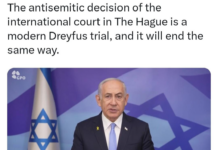
Veteran Arab journalist Abdel Bari Atwan argues that last week’s celebrations of the transfer of the US embassy to occupied Jerusalem were a crucial first step in implementing the so-called “Deal of the Century” which the Trump administration hopes will result in the final collapse of the Palestinian cause.
By rushing to relocate the embassy, and timing the move to coincide with the anniversary of the Nakba, the US and Israel were launching a “trial balloon” to gauge Arab and international reactions prior to unveiling this “deal.”
Regrettably, the reaction was very muted in most of the occupied Palestinian territories other than the Gaza Strip, where mass demonstrations were held for six consecutive weeks in which more than 100 people were killed and 3,000 people injured by Israeli sniper bullets. The same can be said of the response from most Arab and Islamic capitals.
The “leaking process” aimed at marketing the deal in advance began via the Associated Press news agency, which quoted five anonymous US officials as saying that President Donald Trump plans to unveil his plan – drawn up chiefly by his son-in-law Jared Kushner and “peace” envoy Jason Greenblatt under the direct supervision of Israeli Prime Minister Binyamin Netanyahu — in late June after the end of Ramadan.
The official Arab reaction to the embassy move and the Israeli massacre in Gaza was not only muted but complicit, suggesting that the US’s main Arab allies – especially Egypt, Jordan and most of the Gulf states – are aware of the details of the forthcoming American plan. They failed to call for an emergency Arab summit in response, and their attendance at the Islamic summit convened by Turkish President Recep Tayyip Erdogan was (with the exception of Jordan) notably low-level, with most of the Gulf states (other than Kuwait) represented by their foreign ministers.
The fact that the Arab states which have formal diplomatic relations with Israel (Egypt and Jordan) did not dare recall their ambassadors or expel Israeli diplomats from their capitals in protest — even though such measures were taken by non-Arab countries like Turkey, Bolivia, South Africa, Ireland and Belgium — is significant. It could presage some shocking developments in the months to come.
Meanwhile, Egyptian President Abdel Fattah as-Sisi summoned Hamas leader Ismail Haniyeh from Gaza to Cairo – sending a private plane to pick him and his delegation up at al-Arish airport — in an attempt to persuade them, at the request of the US, to put an end to the Return Marches and calm the situation down in the Gaza Strip, and also to discuss proposals for a ten-year truce with Israel. Some Hamas insiders began leaking word that some kind of agreement, which would result in the lifting of the siege on Gaza, could be on the cards.
Subscribe to our newsletter and stay updated on the latest news and updates from around the Muslim world!
Carrot and stick
The US and its Arab clients are pursuing a carrot-and-stick approach towards the Palestinians, or rather towards their leaders in the West Bank and Gaza Strip. The stick is to cut off financial aid and tighten the siege, and the carrot is the promise of Arab and Western cash for the Occupied Territories as payback for relinquishing Jerusalem and the Right to Return and for not opposing the deal.
Sisi’s unexpected and unprecedented decision to reopen the Rafah border crossing to Gaza for the duration of Ramadan was intended to pave the way for an accord under which the March of Return protests would be halted or scaled down, while popular anger would be assuaged by the prospect of improved living conditions.
That, at least, is the idea, after Gaza’s inhabitants, at Hamas’ urging, spoiled the embassy celebrations and exposed the ugly terrorist face of Israel. But things might not go to plan if the Hamas leadership refuses to take the American carrot being presented to it on an Arab plate. It could go either way: there is a strong current within Hamas that advocates opposition.

The details that have been leaked so far about the substance of Trump’s deal speak of enlarging the Gaza Strip by incorporating 720 square kilometres of Egypt’s Sinai Peninsula, perhaps including the towns of al-Arish and Sheikh Zuweida, where a port and airport would be built. In return, Egypt would obtain an equivalent area of occupied Palestinian territory in the Naqab desert.
Meanwhile, the envisaged ultra-modern mega-city of Neom would be built in the Egyptian-Jordanian-Saudi border area, attracting $500 billion of investment, providing ample employment and attracting additional indirect investment into the Egyptian economy. The West Bank, for its part, is offered no more than “economic peace” plus improved self-administration conditions.
The big stick being wielded by the US is the threat to deprive the Palestinian Authority (PA) of financial aid if it declines to go along with this plan. It has already had $200 million frozen from this year’s budget, plus another $65 million withheld from UNRWA’s budget.
The cut-off of all financial support to Jordan from the Gulf states has the same objective: to put pressure on the country, and on its resident Palestinians, to either accept the deal or put up with the consequences. The process of trying to marginalise Jordan and its role began some time ago and is set to intensify.
Media campaign
In the Gulf states, meanwhile, there has been an escalating media campaign aimed at vilifying the Palestinian people in the eyes of the public – including by depicting them as having sold their land to the Israelis and so being undeserving of support. The “electronic army” of Gulf state social media propagandists has been fully enlisted in this controlled and coordinated campaign, as have prominent pro-regime writers, in parallel with the gradual process of normalisation with Israel.
This, too, is part of Gulf regimes’ contribution to easing the way for Trump’s deal. So was the arrest of five Saudi male and female activists who were known for their opposition to normalisation. More such moves can be expected.
To this must be added the targeting of the Resistance Axis region-wide – the attacks on Iranian positions in Syria by Israeli warplanes and missiles, the imposition of sanctions on Hezbollah’s Hassan Nasrallah and nine other party leaders, and the placing of the party’s political and military wings alike on the “terrorist” list. All these measures fall in line with US steps to impose the “deal of the century,” exploiting the current weakness of the Arab and Islamic worlds as a historic opportunity that will not recur.
It will be no surprise if Israel soon announces its acceptance of the Saudi-authored Arab Peace Initiative of 2002 – minus its key provisions, of course, and with the status of occupied Jerusalem having been settled and taken off the table of any future negotiations. We may also see exchanges of visits between Gulf Arab and Israeli officials after Ramadan.
It seems we are set for a summer of normalisation, as the wraps are lifted from this cynical deal.



















